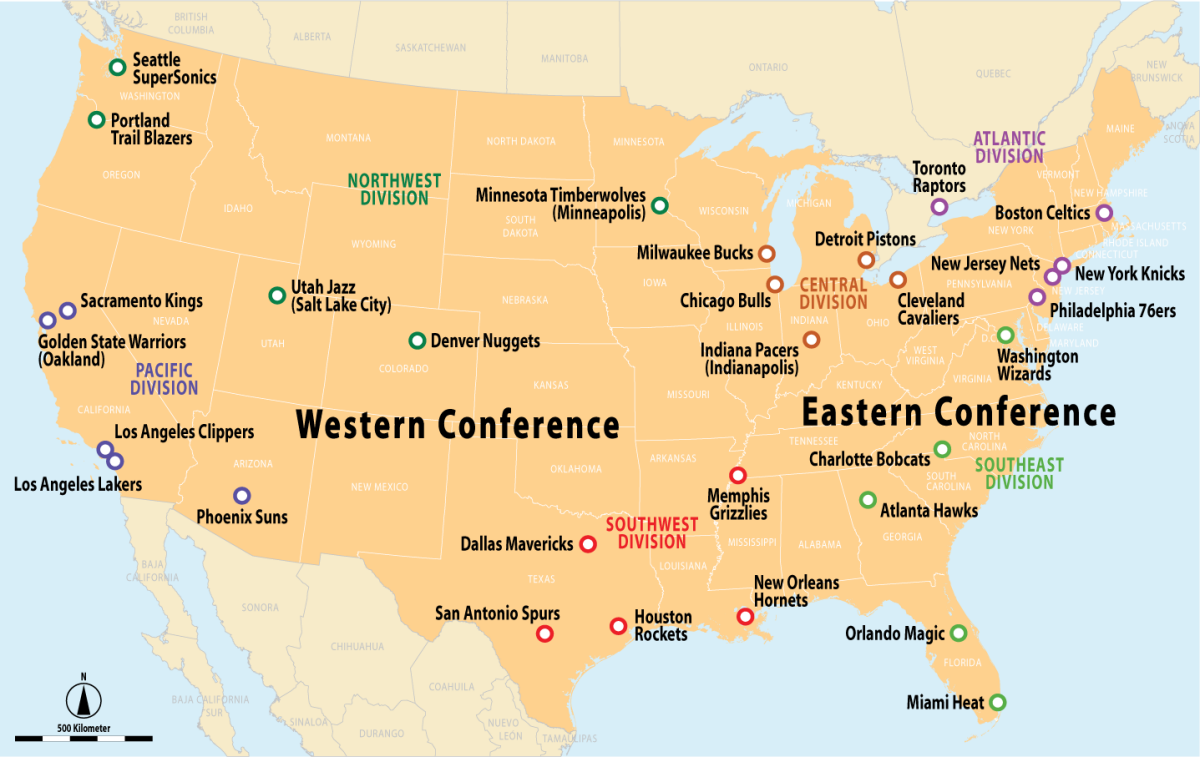What are the 6 NBA divisions? Complete Divisional Alignment Guide
A guide to the divisional alignment of the 30 NBA squads, split into two conferences, with five teams arranged in the Atlantic, the Central and the Southeast Divisions of the Eastern Conference, and the rest in the Pacific, Northwest and Southwest Divisions of the Western Conference.
These changes resulted in the league’s current structure composed of two conferences, Western and Eastern, divided into six divisions. These divisions are:
- Western Conference Northwest division;
- Western Conference Pacific division;
- Western Conference Southwest division;
- Eastern Conference Atlantic division;
- Eastern Conference Central division;
- Eastern Conference Southeast divisions.
When the Charlotte Bobcats became the 30th team in the NBA prior to the 2004-2005 season, the league reorganized its divisional structure in order to optimize match schedules.
Why are there NBA divisions and how do each work?
By 1970, as more teams joined the NBA, the league aligned into two conferences, the Eastern and Western. The addition of the Buffalo Braves (a team that later became the Los Angeles Clippers), the Cleveland Cavaliers and the Portland Trail Blazers prompted the NBA to classify the teams according to their geographical location.
Once the number of NBA teams reached 30 with the Charlotte Bobcats (later Hornets) joining the 2004-2005 season, six divisions came into play consisting of 5 teams and split into two conferences of 3 divisions. The three divisions per conference carried 5 teams that were placed according to their geographical location. Divisional rivalries were born, and thrived.
Related: Gain a competitive edge with our latest NBA Predictions.
According to the current NBA schedule, teams play 82 matches during a season. These games break down as follows:
- Teams play 16 games against their divisional rivals. With 5 teams per division, divisional rivals clash 4 times, twice at home, and 2 times away.
- Teams play a total of 24 games against 6 (out of a possible 10) non-divisional conference opponents, resulting in a breakdown of 4 games against each of these six teams. Similar to the divisional matchups, each team plays 2 of these games at home and 2 away.
- Teams play a total of 12 games against the remaining 4 non-divisional conference rivals, consisting of three-game matchups. Two of the opponents will play two home games and 1 away game, while the other 2 rivals will play 2 away games and host 1 game.
- Teams play a total of 30 games against the 15 from the other conference in a home and away series.
With the divisions in place, qualification and seeding to the postseason had an impact. For the 2005 playoffs, division winners were guaranteed a top three-seed. But in 2016, the NBA ruled that playoff berths were to be determined by the best eight conference records, regardless of divisional standings. Team records in the division served as a tiebreaker for teams vying for a playoff berth.
So, even if their role in deciding playoff positions has been largely reduced, the 6 NBA divisions directly determine a team’s schedule, helping them to optimize their travel costs, among other things. Plus, the divisional rivalries resulted in bolstering fan engagement leading to unforgettable, high-expectations matches.
For example, the Chicago Bulls-Detroit Pistons rivalry in the Central Division has produced some memorable games and the Dallas Mavericks-San Antonio Spurs clash in the Southwest pits a battle between Texas teams.
Here’s an image of how the divisional map looks:
NBA Divisions Map by Maximilian Dörrbecker (Chumwa) (Creative Commons License)

Which division figures to be the toughest? The response centers on the dominant teams of a particular era. For example, the Central Division of the 1980s and 1990s was arguably the strongest in the NBA, sparked by the Chicago Bulls - Detroit Pistons rivalry. Those games were fueled by the antagonism of their stars Michael Jordan and Isaiah Thomas, respectively.
For the 2022-2023 season, some consider the Pacific Division in the Western Conference the best one, with superstars LeBron James (Los Angeles Lakers), Kawhi Leonard (Los Angeles Clippers), and Steph Curry and Klay Thompson (Golden State Warriors) capable of performing at another level.
Over on the Eastern Conference side, the Atlantic Division arguably comes close, with Joel Embiid (Philadelphia 76ers), Kevin Durant and Kyrie Irving (Brooklyn Nets) and Jayson Tatum (Boston Celtics) leading the way.
Related: The best 3 Point Shooters in the NBA
The Eastern Conference
The Eastern Conference consists of fifteen teams that are divided into three divisions of five teams each.
The winner of the Eastern Conference earns the conference champion trophy, named after legend Bob Cousy. Similarly, the Most Valuable Player award of the conference is named after Larry Bird, considered one of the all-time NBA greats. It is no coincidence that both were iconic Boston Celtics players, spanning a combined career era that ranged from the 1960s to the 1980s.
Central Division
The Central Division was born in the 1970 NBA realignment into conferences and divisions. The original teams of the Central Division were the Atlanta Hawks, the Baltimore Bullets, the Cincinnati Royals, and the Cleveland Cavaliers. Only the Cavs remain, as the five teams in the current Central Division are:
- Chicago Bulls
- Cleveland Cavaliers
- Detroit Pistons
- Indiana Pacers
- Milwaukee Bucks
All, except the Indiana Pacers, have won at least one NBA title. The Milwaukee Bucks, with superstar Giannis Antetokounmpo, won the NBA championship in 2021, while the LeBron James-led Cleveland Cavaliers won it in 2016. Michael Jordan, Scottie Pippen and coach Phil Jackson led the Chicago Bulls to 6 NBA titles out of 6 finals they played. Not to be outdone, Chicago’s bitter rival, the Detroit Pistons, won 3 out of 7 NBA finals.
Atlantic Division
The Atlantic Division is one of the most competitive divisions in the NBA, and also one rich in tradition and history that supports passionate fan bases. The teams that form the Atlantic Division are:
- Philadelphia 76ers
- Toronto Raptors
- Boston Celtics
- Brooklyn Nets
- New York Knicks
The Boston Celtics have won 17 NBA championships, the latest in 2022. Along with the Lakers franchise (which includes Minneapolis and Los Angeles), the Celtics have hoisted the league trophy the most.
The Toronto Raptors earned the title in 2019, becoming the first Canadian team to win an NBA championship. They did it with stars Kyle Lowry, Pascal Siakam and Kawhi Leonard.
Southeast Division
The Southeast Division was formed in 2004, with the incursion of the Charlotte Bobcats, one of the founding divisional teams.
The five teams in the Southeast Division are:
- Atlanta Hawks
- Charlotte Hornets
- Miami Heat
- Orlando Magic
- Washington Wizards
The most successful team are the Miami Heat, with three championships and three runner-up finishes. The Heat won the NBA title in 2006, 2012, and 2013, and lost in the 2011, 2014 and 2020 NBA Finals.
The Western Conference
Like the Eastern Conference, the Western Conference is composed of fifteen teams which are organized into three five-team divisions.
There are two trophies awarded in the Western Conference, one to the Western Conference winner, named after iconic Oscar Robertson, and the Western Conference Finals Most Valuable Player, which carries Magic Johnson’s name.
Pacific Division
Since its inception in 1970, the Pacific Division has seen significant changes. For instance, two of the original teams relocated, the San Diego Rockets (to Houston) and the Seattle SuperSonics (to Oklahoma City).
Currently, the Pacific Division’s teams are:
- Golden State Warriors
- Los Angeles Clippers
- Los Angeles Lakers
- Phoenix Suns
- Sacramento Kings
The Pacific Division is arguably the most successful, sparked by legendary Los Angeles Lakers squads and dominating Golden State Warriors teams. Stephen Curry and Klay Thompson have guided the Warriors to four NBA crowns, in 2015, 2017, 2018 and 2022. The Los Angeles Lakers have stacked Magic Johnson, Kareem Abdul-Jabbar, Kobe Bryant, Shaquille O’Neal and LeBron James, among others, to win 15 NBA championships out of the 17 total for the franchise.
Southwest Division
The Southwest Division sprouted into the Western Conference in 2004 and includes three teams from Texas. The teams that play in the Southwest Division are:
- Dallas Mavericks
- Houston Rockets
- Memphis Grizzlies
- New Orleans Pelicans
- San Antonio Spurs
The Spurs won 5 NBA championships in a 15-year span between 1999 and 2014, with Tim Duncan on all five teams. Houston, powered by Hakeem Olajuwon, won the NBA championship back-to-back in 1993 and 1994. The Dallas Mavericks claimed one title in 2011, thanks to the formidable duo of Dirk Nowitzki and Jason Kidd.
Northwest Division
The Northwest Division was conceived in 2004 as part of the 30-team league alignment. Since, one of the original teams in the division, the Seattle SuperSonics, relocated to Oklahoma City as the Thunder. The five teams in the division are:
- Utah Jazz
- Denver Nuggets
- Oklahoma City Thunder
- Portland Trail Blazers
- Minnesota Timberwolves
Only two teams in this division have won NBA titles. In 1977 the Portland Trail Blazers, with Hall of Famer Bill Walton as MVP, defeated the Philadelphia 76ers in the NBA Finals. And in 1979, with Dennis Johnson and Jack Sikma, the Seattle Supersonics trounced the Washington Bullets for their only NBA championship, now part of the shared history with the Oklahoma City Thunder.
The Utah Jazz of Karl Malone and John Stockton reached the NBA Finals in 1997 and 1998, but couldn’t get past Michael Jordan and the Chicago Bulls for the title.
Final thoughts
The 82-game NBA schedule for all teams is dependent on the 6 divisions. The alignment, generally geographic, attempts to minimize player fatigue due to travel and optimize franchise costs while at the same time trigger fan excitement with the promotion of regional rivalries.
If and when additional franchises join the league –whether through expansion or relocation– there is an expectation that divisional alignment would adapt to the needs of the NBA.
FAQ
How do NBA divisions work?
The 6 NBA divisions were created to align the 30 NBA teams with their geographical location and to optimize the season’s match schedule.
What NBA teams are in which division?
Please refer to this map, which classifies the teams per division.
What is the toughest division in the NBA?
The Pacific Division –with the Los Angeles Lakers and the Golden State Warriors– and the Atlantic Division –with the Boston Celtics, Philadelphia 76ers, and Brooklyn Nets– are arguably considered the most competitive divisions in the NBA.
When did the NBA go to 6 divisions?
The 6 divisions were created before the start of the 2004-2005 season, and coincided with the addition of the Charlotte Bobcats as the 30th team in the league.
What are the 6 NBA divisions?
The Northwest, Pacific, and Southwest Divisions compose the Western Conference, and the Atlantic, Central, and Southeast Divisions are part of the Eastern Conference.
For further reading: The average NBA player height in 2023
Our editorial content strives to be highly informative and educational to our audience, especially for visitors who are new or relatively new to analyzing and predicting sporting event results. All of our content is created by informed writers with backgrounds in their subject area and reviewed for omissions or mistakes.
Our editorial team is run by individuals with many years of experience in digital publishing, editorial, and content production. Our editorial content is always marked clearly in any instances where it may be sponsored by a third party, though it is still reviewed by our staff to ensure it remains consistent with our company mission.
- Popular
- Latest









